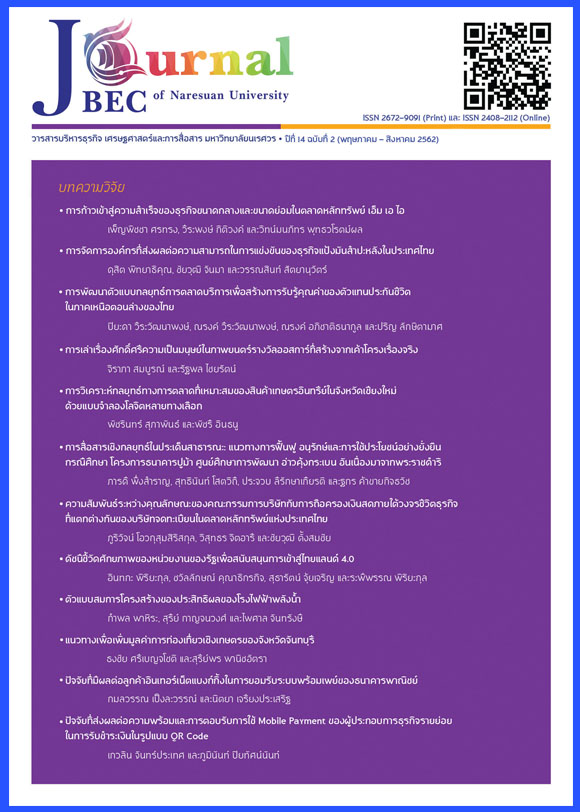Factors of Merchants’ Readiness and Acceptance toward QR Code Payment Adoption Merchants’ Readiness and Acceptance of QR Code Payment Adoption
Main Article Content
Abstract
This research studies about merchants’ readiness and acceptance of QR payment adoption is based on Technology acceptance model with 5 additional factors. This research is a qualitative research using the In-depth interview with Open-ended questions. The population of this research comprises 25 merchants and 4 executives of three major banking service providers which are authorized to provide Standard QR code. The findings indicate that perceived usefulness, perceived ease of use, cost, network externalities, security and trust, personal innovativeness and customer shopping experience are the factors influencing merchants’ acceptance of QR payment. In terms of attitude, most of the merchants have a positive attitude toward QR payment service and are likely to continue using QR payment in the future.
Article Details
References
2. Chareonwongsak, K. (2014). Business opportunities of Asia’s century. Journal of Business, Economics and Communications, 9(1), 3-10.
3. Chen, L. D. (2008). A model of consumer acceptance of mobile payment. International Journal of Mobile Communications, 6(1), 32-52.
4. Chitrattanamongkol, T. (2018). The influence of consumer’s expectation toward electronic service quality, usefulness and ease of use on their acceptance of QR Code technology in payment in Bangkok. Independent Study, M.B.A., Bangkok University, Bangkok.
5. Davis, F. D. (1989). Perceived usefulness, perceived ease of use and user acceptance of information technology. MIS Quarterly, 13(13), 319-340.
6. Denzin, N. K. (1978). The research act: A theoretical orientation to sociological methods. New York: McGraw-Hill.
7. Hayashi, F. and Bradford, T. (2014). Mobile payments: Merchants' perspectives. Federal Reserve Bank of Kansas City Economic Review, 99(2), 33-58.
8. Karaket, W. (2016). Fintech adoption in mobile payment startup industry. Master Thesis, M.S., Thammasat University, Bangkok
9. Katz, M. L. and Shapiro, C. (1985). Network externalities, competition and compatibility. The American Economic Review, 75(3), 424-440.
10. Kim, C., Mirusmonov, M. and Lee, I. (2010). An empirical examination of factors influencing the intention to use mobile payment. Computers in Human Behavior, 26(3), 310-322.
11. Liebana, F. C., Ramos de Luna, I. and Montoro-Ríos, F. J. (2015). User behavior in QR mobile payment system: The QR payment acceptance model. Technology Analysis and Strategic Management, 27(9), 1031-1049.
12. Liguo, L., Zilu, T. and Joon, K. (2017). Tourist satisfaction enhancement using mobile QR code payment: An empirical investigation. Sustainability, 9(7), 1186-1199.
13. Lin, C. P. and Bhattacherjee, A. (2008). Elucidating individual intention to use interactive information technologies: The role of network externalities. International Journal of Electronic Commerce, 13(1), 85-108.
14. Lohawatanakul, S. (2015). Reveal mega trends to AEC. Journal of Business, Economics and Communications, 10(1), 1-3.
15. Mallat, N. (2007). Exploring consumer adoption of mobile payments–A qualitative study. The Journal of Strategic Information Systems, 16(4), 413-432.
16. Miles, M. B., Huberman, A. M. and Saldana, J. (2014). Qualitative data analysis: A method sourcebook (3rd ed.). Arizona: SAGE.
17. National-ePayment. (2016). Project 1: PromptPay. Retrieved February 7, 2018, from http://www.epayment.go.th/home/app/project-1
18. Patton, M. Q. (1999). Enhancing the quality and credibility of qualitative analysis. HSR: Health Services Research, 34(5), 1189-1208.
19. Pholphirul, P. (2007). Demand of network and telecommunication products. Retrieved March 12, 2018, from http://piriya-pholphirul.blogspot.com/2007/02/blog-post.html
20. Terdtultaweedech, N. (2016). Cashless society: Get ready for full cashless society. Retrieved February 7, 2018, from https://www.scbeic.com/th/detail/product/2602
21. Thansettakij. (December 31, 2017). “QR code” is rising. Thansettakij, 37(3,327), 20.
22. Ueasangkomsate, P. (2016). Barriers to e-commerce adoption in Thai Small and Medium Enterprises. Journal of Business, Economics and Communications, 11(2), 33-45.
23. Umphapalin, P. (2018). Factor affecting behavior intention to use Quick Response payment system of consumer in Bangkok. Master Independent Study, M.B.A., Bangkok University, Bangkok.
24. Vierra, T. (2010). Factors influencing the acceptance of mobile payment among mobile phone users in Bangkok. Independent Study, M.S., Thammasat University, Bangkok.
25. Wang, C. C., Lo, S. K. and Fang, W. (2008). Extending the technology acceptance model to mobile telecommunication innovation: The existence of network externalities. Journal of Consumer Behavior, 7(2), 101-110.
26. Xiang, V. (2017). What do you need to know about QR Code pay?. Retrieved March 7, 2018, from www.linkedin.com/pulse/what-do-you-need-know-qr-code-pay-vincent-xiang
27. Yang, S., Lu, Y., Gupta, S., Cao, Y. and Zhang, R. (2012). Mobile payment services adoption across time: An empirical study of the effects of behavioral beliefs, social influences and personal traits. Computers in Human Behavior, 28(1), 129-142.

